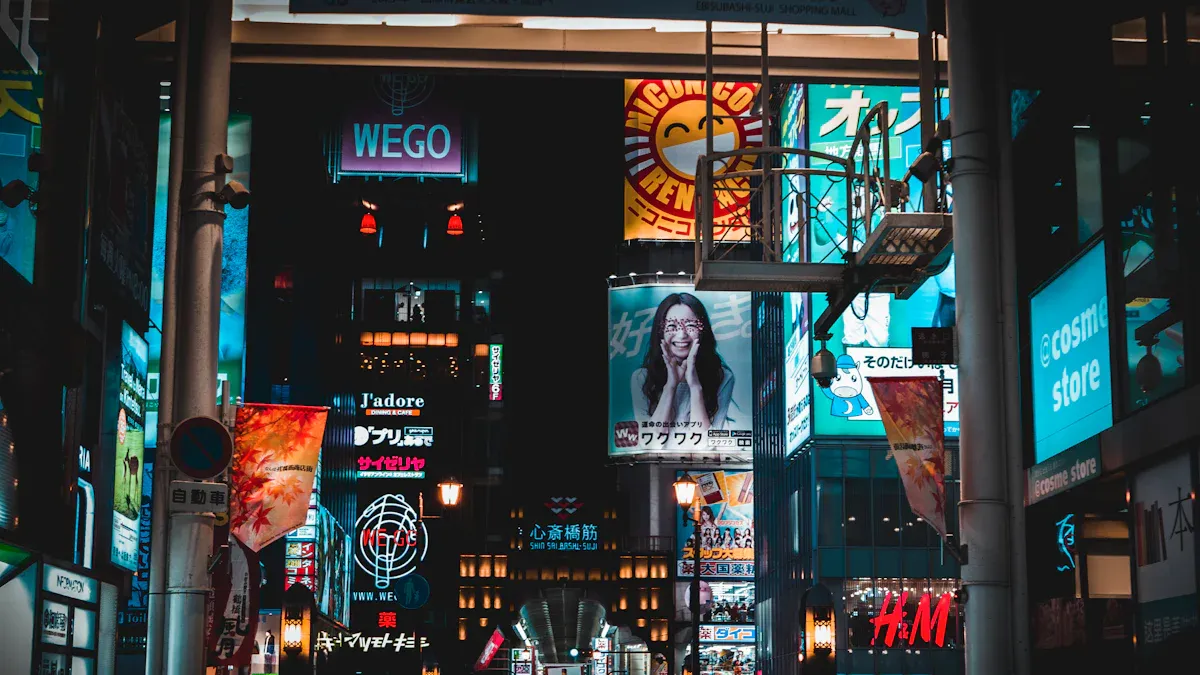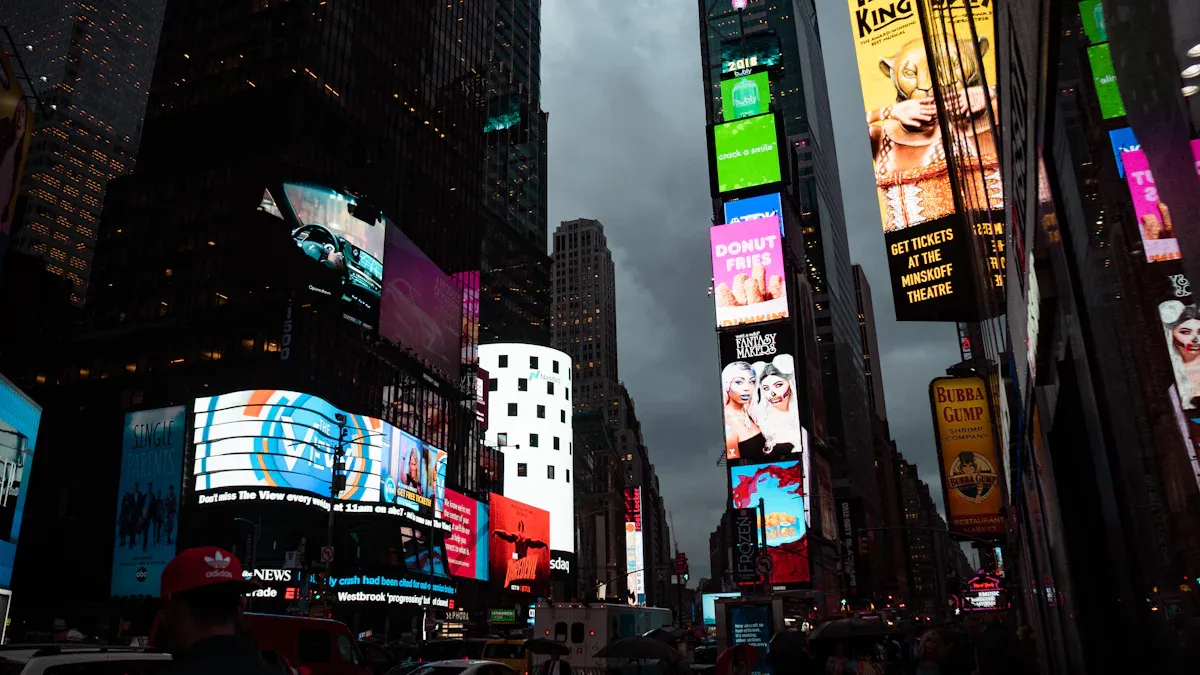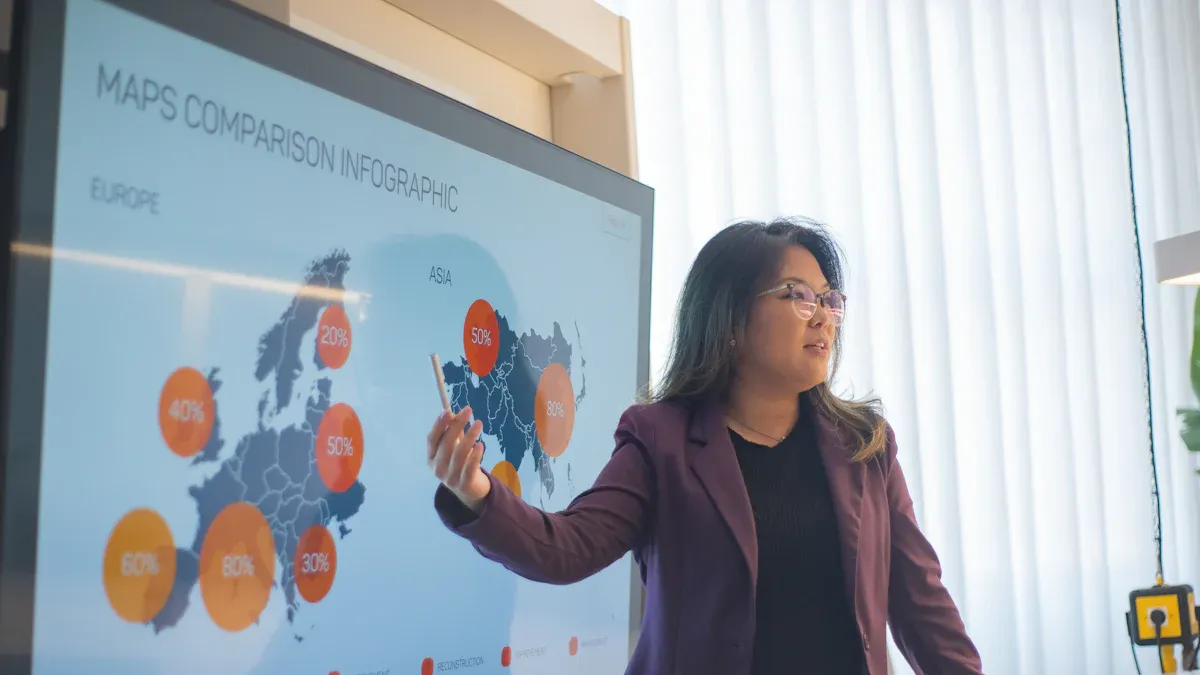Panasonic vs Samsung Digital Signage: Key Differences in Technology, Performance, and Value

Panasonic vs Samsung digital signage products differ significantly in the LCD market. Samsung leads the digital signage industry with a 20% LCD market share and generates much higher revenue than Panasonic. When comparing Panasonic vs Samsung, it’s clear they use different technologies and eco-friendly designs. Samsung offers advanced LCD hardware and smart features, while Panasonic focuses on superior image quality and energy efficiency. Samsung’s LCD signage delivers strong performance at competitive prices. The table below highlights the revenue figures for each company in the digital signage sector:
Company | Total Revenue (USD Billion) | Gross Profit (USD Billion) | Segment Revenue (USD Billion) |
|---|---|---|---|
Samsung | 234 | 86.8 | 25.7 |
Panasonic | 55.8 | 2.7 | N/A |
When considering Panasonic vs Samsung LCD signage, buyers can choose based on technology, value, and digital performance.
Key Takeaways
Samsung is ahead with microled technology and smart tools. These give bright pictures, save energy, and are easy to control from far away.
Panasonic works on great picture quality and flexible display shapes. They use eco-friendly materials that save power and last a long time.
Samsung’s digital signs are good for big companies. They help if you need signs that can grow and let people interact. Panasonic is better for small groups who want to save energy and see clear images.
Both brands have strong, long-lasting displays and good help. But Samsung has more tools for remote control. Panasonic is better at using green technology.
Picking the best digital sign depends on your business size and goals. You should think about smart tools, saving energy, or picture quality.
Panasonic vs Samsung: Technology

Display Technology
The lcd digital signage market changes quickly. Panasonic and Samsung use different display technology. Samsung is a leader with microled displays. One example is "The Wall," which is 462 inches wide. Microled gives bright colors and high brightness. It does not have burn-in problems. These displays last longer than lcd or OLED. Samsung also makes energy-saving displays. They use e-Paper and digital ink, which need almost no power.
Panasonic makes video walls, projectors, and 4K lcd displays. Their screens can be transparent, fold, or curve. Panasonic sells to offices, schools, and studios. They care about clear images and true colors. Their displays have high resolution and many shapes for work use.
Brand | Display Technology Highlights | Target Markets |
|---|---|---|
Samsung | Microled, e-Paper, QLED, Neo QLED, high-brightness lcd, digital ink, energy-efficient displays | Retail, public spaces, control rooms |
Panasonic | Seamless video walls, 4K lcd, projectors, transparent/folding/curved displays | Corporate, education, studios |
Samsung’s microled is known for great pictures and saving energy. Panasonic’s lcd displays are best for image quality and flexible setups.
Software & Integration
Software is important for lcd digital signage. Samsung has strong software. Their signs let you manage screens from far away. They use AI to watch and control displays. You can schedule content easily. One dashboard controls many screens. The system checks for problems and updates itself. This helps IT teams do their jobs faster.
Panasonic’s software works well with other AV systems. Their signs run on many operating systems. They work with different content tools. Panasonic’s software helps switch between screens smoothly. This is useful for video walls. They make sure their software is easy to use at work.
Note: Samsung is best for remote control and AI. Panasonic is best for working with many AV systems.
Smart Features
Smart features make Panasonic and Samsung different. Samsung uses strong hardware and smart platforms. Their signs have sensors to count people and measure the audience. They support touch and change content in real time. Samsung’s microled uses AI to change brightness and color. Their displays save energy and lower costs.
Panasonic uses green materials and saves power. Their lcd signs use parts that can be recycled. They use less energy. Panasonic’s smart features include auto brightness and tools to schedule content. Their displays last a long time and are good for the planet.
Samsung: Sensors, AI content, microled, energy-saving displays
Panasonic: Green materials, energy-saving lcd, easy content scheduling
Both brands have smart features that add value. Samsung’s microled and AI are good for busy places. Panasonic’s focus on green tech is good for groups that want eco-friendly lcd digital signage.
Signage Performance

Reliability & Durability
Panasonic and Samsung make digital signage that lasts a long time. Panasonic cares about the environment and builds strong displays. Their lcd screens use recycled parts and save energy. These displays can work for many years, even in tough places. Panasonic gives warranties that fix most problems, so buyers feel safe.
Samsung makes signs for busy places and long use. Their microled and lcd screens can handle lots of use every day. Samsung uses special cooling and strong frames. Many Samsung displays have longer warranties and help at your location. This means less time when signs are broken and more time working.
Brand | Lifespan | Build Quality | Warranty & Support |
|---|---|---|---|
Panasonic | 50,000+ hours | Eco-friendly, robust | Standard to extended |
Samsung | 60,000+ hours | Commercial-grade, strong | Extended, on-site options |
Panasonic is known for being green and tough. Samsung is best for strong signs and good support.
User Experience
Both brands want their digital signs to be easy to use. Panasonic makes lcd screens that are simple to set up. Their menus let you change what shows fast. Many Panasonic screens work right away when plugged in. This helps businesses start using them quickly.
Samsung adds smart tools and remote control. Their screens use one dashboard for everything. IT teams can manage many screens from one spot. Samsung’s microled and lcd signs can update and schedule content in real time. Touchscreens and sensors make it fun for users.
Panasonic: Easy setup, quick content changes, plug-and-play lcd screens.
Samsung: One place to control, remote updates, interactive digital signs.
Many people like Samsung’s remote tools for big groups. Panasonic’s easy setup is good for small teams.
Real-World Feedback
Samsung digital signs are used in many places. Schools like The King’s Academy use Samsung screens to share news. Sports teams like the Utah Jazz use them to make games more fun. Hospitals such as Bon Secours St. Francis Health System use Samsung signs to help patients and guests. Stores and casinos, like Sycuan Casino Resort, use Samsung signs to show deals and get customers interested. Airports and restaurants also use Samsung screens to help people.
Samsung signs help schools and hospitals share information.
Sports places use Samsung screens to make fans happy.
Stores and hotels say Samsung signs help them get more customers and sell more.
Digital signs, like lcd and microled, work well in stores. McDonald’s uses self-service screens to make lines shorter and people happier. Adidas pop-up shops use digital signs to show products and deals, bringing in more people. Sephora uses screens to give tips and let people try things, which helps them sell more and keep customers coming back.
These stories show that digital signs, especially Samsung’s, help with sharing news, getting people involved, and working better. Panasonic does not have as many stories, but their strong and green signs are good for groups that care about the planet.
Value in the LCD Digital Signage Market
Pricing & Ownership Cost
There are many lcd digital signage options for buyers. Samsung has prices that are not too high. Many companies pick Samsung because it does not cost much to own. Samsung gives extra features in its lcd screens but keeps prices low. Panasonic lets buyers pick signs that fit what they want. Panasonic can cost more at first. But you get value from signs made just for you and saving energy later.
Brand | Initial Price | Customization | Energy Efficiency | Total Cost of Ownership |
|---|---|---|---|---|
Lower | Standard | High | Competitive | |
Panasonic | Higher | High | Very High | Long-term Savings |
People should look at both starting price and long-term value before buying lcd digital signage.
ROI & Scalability
Getting your money’s worth is important in lcd digital signage. Samsung makes it easy for businesses to grow fast. Companies can add more lcd screens as they get bigger. Samsung’s digital signs work for small stores and big chains. Panasonic gives good value for groups who want to save energy and have custom screens. Their signs last longer and use less power. This means you spend less money over time. Planning for growth helps companies in the lcd digital signage market.
Samsung: Easy to add more screens, good for growing businesses.
Panasonic: Best for saving money over time and custom signs.
Support & Service
Support and service are important for lcd digital signage. Samsung gives strong help after you buy. They send people to fix problems and do repairs fast. Panasonic has detailed plans for service. Their team helps set up and take care of the signs. Both brands know good support matters for lcd digital signage. Good service keeps signs working and protects your money.
Good support helps businesses get the most out of their lcd digital signage.
Use Case Recommendations
Industry Fit
Panasonic and Samsung are top brands for digital signage. They both have strong products for different types of businesses. Many stores pick Samsung because it has smart signs and touch screens. These help stores get shoppers interested and give them special deals. Samsung’s kiosks and screens let people help themselves and see new offers right away. This is great for busy stores.
Both brands work well in offices. Samsung’s SMART Signage and Flip screens help companies talk to workers and greet visitors. These signs let companies share news fast and keep everyone updated. Panasonic also makes good signs for offices. Their signs show clear messages and use less power.
Schools also use both brands. Panasonic has whiteboards and 4K touch screens for classrooms. These help teachers teach better and make lessons fun. Samsung’s signs are good for schools too. They help teachers show lessons and get students to join in.
Tip: Pick the signage that fits your business type for the best results.
Business Size & Needs
The best sign depends on how big your business is and what you need. Big stores and companies often choose Samsung. Samsung’s signs are easy to add more as you grow. This helps big businesses keep up with new trends.
Small businesses and schools might like Panasonic more. Panasonic’s signs save money over time and are simple to set up. They use less energy and last a long time. This helps small teams spend less. Panasonic also uses green materials, which is good for groups that care about the planet.
Samsung: Best for big businesses and getting lots of people interested.
Panasonic: Good for small teams, custom signs, and saving energy.
Note: Both brands have great signs, but the best one depends on your goals and who you want to reach.
Panasonic and Samsung both make good digital signs, but they are good at different things. Samsung is best if you want smart tools and to control signs from far away. Panasonic is better if you care about saving energy and having clear pictures. Big stores or companies should pick Samsung because it has new technology and is easy to add more screens. Panasonic is a good choice for small groups that want to use less power. Every business should think about what it needs before picking a sign.
Tip: Pick signs that have the right features for your business.
FAQ
What are the main differences between Panasonic and Samsung digital signage solutions?
Panasonic and Samsung digital signage are not the same. Samsung uses microled and makes displays that save energy. Panasonic cares about clear pictures and uses eco-friendly parts. Both brands work well and have interactive features for lcd digital signage.
Which brand offers better audience engagement features?
Samsung has more ways for people to interact, like sensors and live updates. Panasonic gives strong screens with sharp images. Both help people pay attention, but Samsung is often better in busy stores and public places.
How do Panasonic and Samsung address energy efficiency in their displays?
Panasonic uses green parts and makes screens that use less power. Samsung uses microled and smart sensors to save energy. Both brands help the planet and give good value over time.
Are these digital signage solutions scalable for growing businesses?
Both Panasonic and Samsung can grow with your business. Samsung’s lcd screens and software make it simple to add more. Panasonic lets you pick signs that fit your business size. Both brands help companies get bigger in lcd digital signage.
What digital signage trends should businesses watch in 2024?
Businesses should look for microled, interactive screens, and AI content tools. The industry now wants screens that save energy and work well together. Panasonic and Samsung both keep up with these new digital signage trends.
See Also
Understanding Digital Signage Monitors: Features, Uses, And Choosing Tips
Exploring Digital Signage: Advantages, Technology, And Deployment Methods
Measuring Digital Signage Return On Investment And Business Effects
A Guide To LED Signage: Varieties, Tech, And Installation Plans
Best Ten Digital Signage Screens For Commercial Business Use

